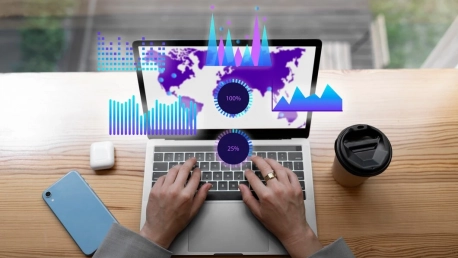The text analytics market is rapidly expanding as it becomes crucial for deciphering the massive amounts of unstructured data generated every day. It plays a vital role in converting this torrent of text into useful insights, which are essential for making informed decisions. Companies and organizations are increasingly relying on text analytics to make sense of the data deluge and extract meaningful information that can drive their strategies and decisions. As digital data continues to grow, the importance of text analytics is underscored by its ability to analyze, understand, and interpret vast volumes of textual content. This analysis is paramount for businesses looking to gain a competitive edge by leveraging the hidden knowledge within their data. Thus, the text analytics field is not just growing; it is becoming indispensable in the age of big data.
Growth Drivers
Demand for Social Media and Predictive Analytics
The surge in text analytics is driven by the need to understand social media dynamics and predict future trends. As social media generates large volumes of data, companies are eager to extract insights about consumer opinions and emerging patterns. This trend goes beyond simply capturing current customer sentiments; it’s a strategic move to anticipate upcoming market behavior. Consequently, businesses are fine-tuning their analytics tools for better foresight. This predictive power is becoming crucial as firms seek to swiftly respond to the volatile market landscape, effectively equipping them to stay ahead of the curve. The evolving field of analytics stands at the forefront of equipping enterprises with the ability to foresee and respond to market changes, ensuring their resilience in an ever-changing economy.
Industry-Specific Applications
The expansion of the text analytics field is being fueled by the emergence of tailored applications catering to the unique needs of various industries. These bespoke solutions are crafted to handle the distinct terminologies and processes inherent to sectors like healthcare, finance, and retail, reflecting the growing recognition of their potential by enterprises. The complexity of today’s business operations and the intricate nature of the data involved necessitate specialized analytics tools. Such tools are capable of delving deeper into sector-specific data, thereby unlocking more sophisticated insights. This not only enhances business efficiency but also paves the way for innovative practices within industries. As companies continue to seek out custom text analytics applications, the market is likely to keep growing, driven by the demand for more precise and industry-relevant insights.
Market Challenges
Data Privacy and Security Concerns
Text analytics offers remarkable insights, but data privacy and security concerns loom large for organizations. With strict laws like the GDPR guiding data use, companies tread carefully, wary of analytics tools that might expose sensitive data. Ensuring security and compliance with evolving privacy standards is a critical priority for text analytics platforms. These tools must balance their analytical capabilities with stringent measures to protect sensitive information and uphold user trust. As companies navigate the complex landscape of data management, they are compelled to seek out text analytics solutions that demonstrate both robust functionality and an unwavering commitment to data protection. Consequently, developers of these solutions must prioritize advancements in security to match their analytical prowess, assuring organizations that harnessing the power of text analytics does not come at the expense of crucial data safety.
Shortage of Skilled Professionals
Adding to the challenges, there exists a palpable shortage of skilled professionals who have mastery over text analytics methodologies. This gap in expertise acts as a throttle on the growth engine of this market, with enterprises struggling to find talent that can draw the most value from their textual data. As such, educational initiatives and professional development are imperative to close this skills gap and empower a new generation of data scientists and analysts capable of navigating the complex landscapes of text analytics.In conclusion, while these challenges are significant, they are surmountable. The text analytics market forecasts depict a future rich with innovation and strategic advancement as businesses increasingly prioritize data-driven decision-making. With more refined solutions on the horizon, the text analytics market is set to not just grow, but to revolutionize the way we comprehend and utilize information in the data-centric era.









